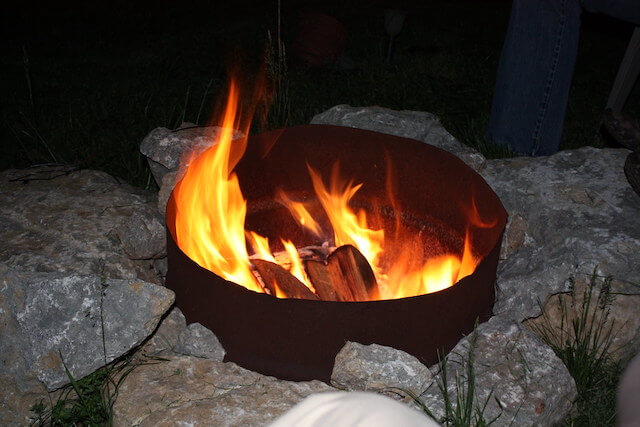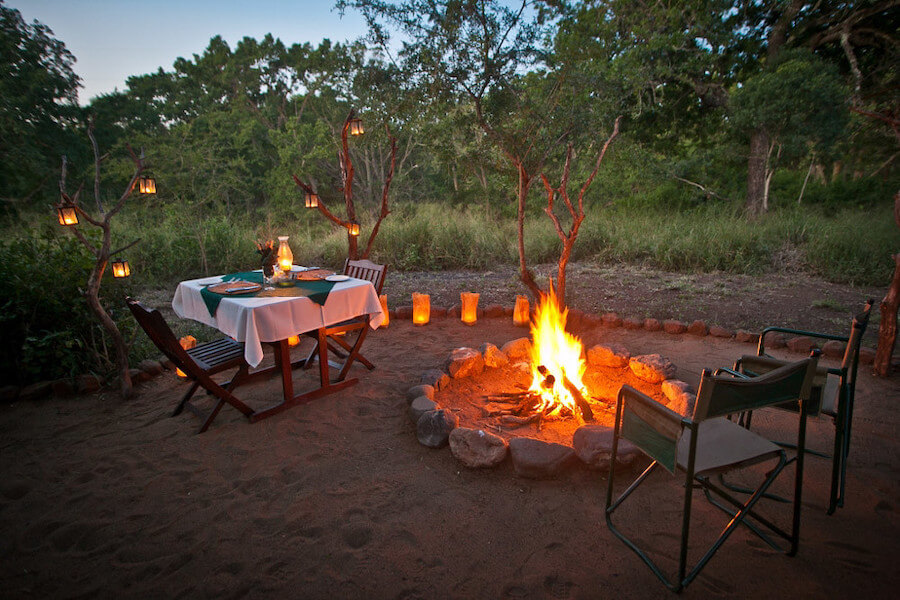How much natural gas does a fire pit use? The answer indicates how efficiently the device can work, which is important when choosing fuel for your fire pit.
This post will give you a direct answer to this question. You can also discover everything about a natural gas fire pit. Let’s dig into the details!
Table of Contents
How Much Natural Gas Does A Fire Pit Use?
A 100,000-BTU fire pit burns about 97 cubic feet of gas. Meanwhile, one cubic foot of the gas has 1,030 BTUs.
We use BTU to illustrate the energy consumption of a machine.
There is not much to say about these figures until we compare them with propane fire pits, and here is what we get: The same fire pit only burns 40 cubic feet of propane at the same time.
As a result, we can conclude that natural gas is less efficient than propane, which has twice the energy efficiency.

Benefits And Drawbacks Of A Natural Gas Fire Pit
Many users switch to natural gas fire pits because of their outstanding benefits.
However, it doesn’t mean that they are perfect. If you intend to buy them, expect both pros and cons as follows:
Benefits
- Clean burning
This kind of fire pit allows you to ignite in an eco-friendly way as it offers clean burning. It means that there will be reduced toxins generated.
Moreover, a natural gas flame produces less CO and CO2 than its oil and gasoline counterparts do.
- Reduced risks
Methane makes up most of the natural gas, which has a low density and increases when emitted into the environment. This phenomenon results in a lower possibility of accidental combustion.
This form of fuel has no smell in its natural state, but you can sense a specific smell. Hence, you can detect undesired gas leaks quickly.
- Convenience
Most households have already joined a hard-pipe supply system for natural gas. As a result, there will be a convenient and steady bank for your gas fire pit.
You can regulate the flame’s intensity if there is a stable gas supply. Additionally, it eliminates the annoyance of having to refill the tank continuously.
- Design
Natural gas fire pits are ideal for commercial settings because of their attractive and functional design. They offer a clear flame, which minimizes the likelihood of cinder.
- Low price
Natural gas fire pits are a superior option from a financial perspective. They are excellent for homeowners that have lower operating costs.

Drawbacks
- Invisibility in the daylight
You will find it hard to detect the flame in daylight. Therefore, this option may not be ideal if you intend to wow your friends with a big flame. Such heat can only handle your basic requirements for cooking.
- Difficult transportation
Natural gas has a low density, making transportation difficult. So, you can only use the fire pit at a fixed location in your home, where it can access the gas supply.
- Low efficiency
You should take your specific demands into account when assessing fuel efficiency. In this case, natural gas has a smaller BTU than liquid propane. Hence, it’s a less efficient option.
- Hard to install
A natural gas-fueled unit needs professional installation. Connecting the fire pit to the gas line is not a simple task.

Which Is Better: A Natural Gas Or Propane Fire Pit?
The battle between natural gas and propane fuel for fire pits remains aggressive.
Both are good, but only one can meet all your needs. So please check their price, safety, and fuel efficiency to determine the winner.
Price
Although the prices can change, propane is generally more costly than natural gas. Hence, propane can typically be the less expensive alternative for your new patio area if you have gas linked up in your backyard.
Safety
Since propane has a far smaller flammability spectrum than natural gas, it is safer because there will be fewer fire risks.
However, be cautious when handling any gas supply. Ensure that you have set everything up correctly, and turn off the gas when not using it.
By having a gas-certified expert frequently examine the fire pit and other gas-powered equipment, you can always take good care of them. The expert also ensures that everything operates safely and you can relax near your fire pit.
Moreover, propane is a more eco-friendly option. Although natural gas offers clean burning, it emits more methane. Meanwhile, propane produces less greenhouse gas, making it an excellent choice for eco-fuel uses.
Soot is another crucial factor to check when it comes to safety. Compared to natural gas, propane is more famous for being sootier. However, if the fire pit is spitting out black soot, there probably is a problem, so you should examine it.
If the ratio of oxygen/air to propane is improper, propane may form soot. In this situation, ensure that the regulator and connecting piece you are using are appropriate and set correctly.
Fuel efficiency
As aforementioned, propane is a more fuel-efficient solution. It burns fewer cubic feet of energy while producing the same heat level.

Can You Convert Any Propane Fire Pit To Natural Gas?
The primary concern when switching a propane fire pit to a natural gas one is safety. Sadly, it is a legitimate issue because of the character of the fuels utilized.
Your fire pit can run on natural gas without risk. Using natural gas is safe if it can accommodate the conversion.
Don’t forget to ask the fire pit supplier if you can convert your unit safely. Additionally, an expert can help perform the conversion for you.
The conversion from propane to natural gas has some features that will make the practice safer and minimize the risk.
- Use a conversion kit at all times. For instance, you can’t connect a propane fire pit straight to the natural gas supply without completing the required conversion.
- Buy the right conversion kit. Employ only that conversion kit for the conversion when the fire pit’s maker suggests it.
- Install new gas hoses. Remember to use the appropriate hoses that are suitable for natural gas when changing to natural gas instead of using older ones, which may break down.
- Adhere strictly to the kit’s guidelines. Never miss a step in the instructions; only utilize components suggested to complete the task.
- If in doubt, talk to an expert. Hire a professional installer to visit and do the conversion if you are not confident about the switchover and the connection to your gas line.
You must ask a qualified mechanic to perform these tasks for you to ensure safety. You might not have a choice but to hire a pro in this situation.
After making sure that you buy the right kit and your fire pit is compatible for the conversion, please follow these steps to convert the fuel:
- Pick a propane tank and take out its hoses and connectors.
- Consult the conversion kit’s instructions to insert the natural gas hoses and connectors on your fire pit.
- Connect the natural gas pipes to the newly-installed connectors.
- Ask a pro to hook up the gas line. But if you already have it, connect it from the kir to your natural gas pipe using the correct connectors.
- Check for gas leaks by turning the gas on and running soapy water over the connectors and pipes. The bubbles will form where the gas leaks.

Frequently Asked Questions
1. Can a fire pit use natural gas?
Yes, you can use natural gas to power your fire pit. It’s practical and economical if you have already installed a gas line that runs to your home.
You won’t ever have to worry about being out of fuel, and you’ll just pay your regular bill for the consumption.
2. How much is a natural gas fire pit?
The cheapest fire pits cost about $600. Meanwhile, a big marble fire pit will cost you more than $3,000.
Although this price seems high, it’s worthwhile to spend the extra money on a high-quality and reliable heat supply, especially if you intend to use your patio as outdoor living space all year long.
Remember that there can be additional installation costs when picking a natural gas device. You’ll pay for a professional installation unless a functional gas line is already present at that position.
3. Are natural gas fire pits worth it?
Yes. This model is an eco-friendly solution and reduces the chances of accidental combustion. You may also love its stunning design.
Conclusion
Natural gas fire pits don’t have an ideal fuel consumption. Hence, they use up much fuel in one hour, especially when compared to propane models.
So now the answer is clear. If you still have questions about this topic, please let us know. We will solve it for you.
Thank you for reading!

